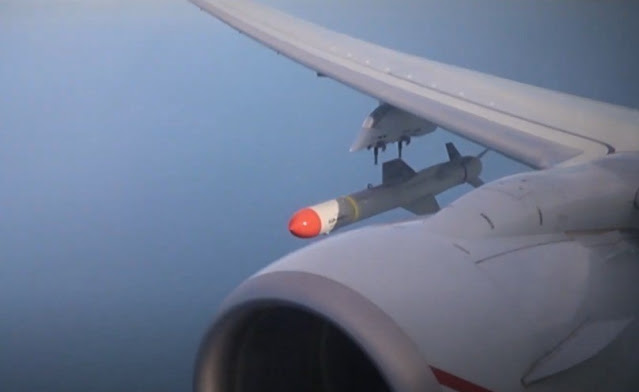 |
| airshwk |
30 September 2022
From Lt. Joseph
Reed, Patrol Squadron NINE
ATLANTIC OCEAN - Patrol Squadron Nine (VP-9) recently had the unique opportunity to participate in Atlantic Thunder 2022, a joint, multi-phase, multinational exercise designed to increase NATO interoperability and strengthen the United States-United Kingdom strategic partnership. The highlight of the exercise for VP-9 occurred with a coordinated time-on-target strike of the decommissioned Oliver Hazard Perry Class frigate USS Boone.
Various joint and multinational assets collaborated on the Hebrides Deep Sea Range off Scotland’s northwest coast in order to achieve the exercise’s main tactical objective, sinking the decommissioned USS Boone. Combat Air Crew Six (CAC-6) was selected to carry out the coordinated time on target strike portion of the exercise with the AGM-84D Harpoon, an anti-ship missile developed by Boeing. Among the other assets that joined CAC-6 and VP-9 in other phases of the exercise were the Royal Navy’s HMS Westminster and its Agusta-Westland AW159 Wildcat Helicopter, three Royal Air Force Typhoons of the 41st Squadron, one U.S. Air Force McDonnell-Douglas F-15E Strike Eagle, and a U.S. Navy submarine. Additionally, range clearance safety was provided by other U.S. P-8A’s from VP-9’s sister squadron, VP-46.
Atlantic Thunder 2022 proved to be a rousing success for all participants, as it not only accomplished all of its primary objectives and sunk the decommissioned USS Boone, but according to the UK’s after action report, the process “achieved several firsts for the U.K. and U.S. in terms of advanced warfighting techniques and delivering complex weapon effects against a realistic target.” Ultimately, the ship formerly known as the USS Boone stood no chance against the “remarkable amount of combined firepower within a short period.” First to hit the ex-Boone were two SM-6 missiles, courtesy of the HMS Westminster. This was followed in short order by the coordinated Harpoon shot conducted by CAC-6 and the HMS Westminster. At precisely 1521Z, the AGM-84D Harpoon launched from the P-8A had a rendezvous with two surface launched AGM-84D Harpoons via the HMS Westminster into the hull of the ex-Boone. The HMS Westminster’s portion of coordinated time on target strike included passive over-the-horizon-targeting generated by U.S. Naval Integrated Fires (NIFE), marking the first time this type of targeting has ever been accomplished against a real life target with multinational collaboration. Raymond O’Toole, Principle Deputy Director, Operational Test and Evaluation from the Office of the Secretary of Defense remarked on this coordinated targeting, stating, “What we’ve demonstrated through this exercise is a new capability–to gain and exchange information for targeting purposes.”
Coordinated time on target shots such as the one conducted by CAC-6 and the HMS Westminster require precise multinational cooperation via detailed planning, communications, and tactical data link employment from multiple nations and services. Successful coordinated shots are remarkably effective in overwhelming a potential combatant’s defenses by delivering rapid amounts of ordnance on target simultaneously and from multiple trajectories and domains. “What we’ve seen in Atlantic Thunder today, is that with Royal Air Force, U.S. Air Force, U.S. Navy, and Royal Navy all operating together [with] helicopters, fixed-wing aircraft, ships, and a submarine, every one of which is capable of going to war tomorrow, we’ve proven it today for the first time in decades in the Atlantic,” summed up Royal Navy Rear Admiral James Parkin.
Following VP-9’s successful coordinated Harpoon shot with the HMS Westminster, the ex-Boone endured several more rounds of punishment from exercise participants. The three RAF Typhoons arrived in short order to deploy four Paveway IV precision guided missiles onto ex-Boone. This was quickly followed by the Wildcat Helicopter’s two Martlet missiles and shortly thereafter two Joint Direct Attack Munitions (JDAM) dropped by the F-15E Strike Eagle. The sub-launched munition and Explosive Ordnance Disposal live charges delivered the final blow against the ex-Boone, sending her to the depths of the North Atlantic in over 6,500 feet of water.
Notably, the decommissioned USS Boone was prepared and configured specifically to meet stringent Environmental Protection Agency (EPA) standards. This was done to mitigate potential adverse effects and keep risk to the environment as low as practicable. In addition to the ex-Boone’s configuration, strict acoustic and visual monitoring from multiple sources on the range ensured that the risk posed by the exercise to marine mammals was extremely low.
VP-9’s contribution to Atlantic Thunder 2022 was critical to the exercise’s overall success and demonstrated the P-8A’s and MPRF’s ability to provide long range, coordinated strike capability in the maritime domain, with the added challenge of multi-national and multi-service planning and coordination.
Commanded by Cmdr. James J. Donchez, and based out of NAS Whidbey Island, Washington, the 279 Sailors assigned to Patrol Squadron Nine (VP-9) are currently deployed to the Sixth Fleet AOR and operate the P-8A Poseidon Maritime Patrol Aircraft.

No comments:
Post a Comment